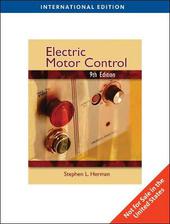
|
Electric Motor Control, International Edition
Paperback
Main Details
| Title |
Electric Motor Control, International Edition
|
| Authors and Contributors |
By (author) Stephen L. Herman
|
| Physical Properties |
| Format:Paperback | | Pages:400 | | Dimensions(mm): Height 272,Width 215 |
|
| Category/Genre | Electrical engineering |
|---|
| ISBN/Barcode |
9780840031594
|
| Classifications | Dewey:621.46 |
|---|
| Audience | | Tertiary Education (US: College) | |
|---|
| Edition |
9th edition
|
|
Publishing Details |
| Publisher |
Cengage Learning, Inc
|
| Imprint |
Delmar Cengage Learning
|
| Publication Date |
25 August 2009 |
| Publication Country |
United States
|
Description
With a highly practical approach, ELECTRIC MOTOR CONTROL, International Edition provides a useful and effective tool for anyone who will install, monitor, and/or maintain motor controls. The book begins by introducing the simplest of equipment and then builds upon this knowledge, step-by-step, enabling readers to learn how to draw and interpret motor control schematic diagrams. Subsequent units provide useful information on motor control components and how they are connected to form complete control circuits.
Author Biography
Stephen L. Herman is a retired electrician and teacher with more than 30 years of experience to his credit. A seasoned author, his reader-friendly textbooks on electricity and mathematics are popular with students and instructors alike. For two decades Mr. Herman was lead instructor for the Electrical Technology Curriculum at Lee College in Baytown, Texas, where he received an Excellence in Education Award from the Halliburton Education Foundation. He also taught at Randolph Community College in Asheboro, N.C., for nine years and helped establish an electrical curriculum for Northeast Texas Community College in Mount Pleasant, Texas. His additional publications include ELECTRIC MOTOR CONTROL, ELECTRICITY AND CONTROLS FOR HVAC/R, INDUSTRIAL MOTOR CONTROLS, UNDERSTANDING MOTOR CONTROLS, ELECTRONICS FOR ELECTRICIANS, ELECTRICAL WIRING INDUSTRIAL, ALTERNATING CURRENT FUNDAMENTALS, DIRECT CURRENT FUNDAMENTALS, ELECTRICAL STUDIES FOR TRADES, ELECTRICAL PRINCIPLES, ELECTRICAL TRANSFORMERS AND ROTATING MACHINES, EXPERIMENTS IN ELECTRICITY FOR USE WITH LAB VOLT EQUIPMENT, THE COMPLETE LABORATORY MANUAL FOR ELECTRICITY, and PRACTICAL PROBLEMS IN MATHEMATICS FOR ELECTRICIANS.
Reviews1. General Principles of Electric Motor Control. 2. Fractional and Integral Horsepower Manual Motor Starters. 3. Magnetic Line Voltage Starters. 4. Symbols. 5. Interpretation and Application of Simple Wiring and Elementary Diagrams. 6. Push Buttons and Control Stations. 7. Relays. 8. Contactors. 9. Timing Relays. 10. Pressure Switches and Regulators. 11. Float Switches. 12. Flow Switches. 13. Limit Switches and Proximity Control. 14. Phase Failure Relays. 15. Solenoid Valves. 16. Temperature Switches. 17. Two-Wire Controls. 18. Three-Wire and Separate Controls. 19. Hand-Off-Automatic Controls. 20. Multiple Push Button Stations. 21. Interlocking Methods for Reversing Control. 22. Sequence Control. 23. Jogging (Inching) Control Circuits. 24. Time-Delay, Low-Voltage Release Relay. 25. The Motor and Starting Methods. 26. Primary Resistor-Type Starters. 27. Autotransformer Starters. 28. Part Winding Motor Starters. 29. Automatic Starters for Star-Delta Motors. 30. AC Solid-State Reduced Voltage Controller. 31. Controllers for Two-Speed, Two-Winding (Separate Winding) Motors. 32. Two-Speed, One-Winding (Consequent Pole) Motor Controller. 33. Four-Speed, Two-Winding (consequent Pole) Motor Controller. 34. Wound Rotor Motors and Manual Speed Control. 35. Push Button Speed Selection. 36. Automatic Acceleration for Wound Rotor Motors. 37. Automatic Speed Control for Wound Rotor Motors. 38. Solid-State Adjustable Speed Controller for AC Wound Rotor Motors. 39. Synchronous Motor Operation. 40. Push Button Synchronizing. 41. Timed Semiautomatic Synchronizing. 42. Synchronous Automatic Motor Starter. 43. About DC Motors. 44. Use of Reduced Voltage for Starting. 45. Across-the-Line Starting. 46. Compensating and Definite Time Control Starting. 47. Solid-State Adjustable Speed Control. 48. Plugging. 49. Electric Brakes. 50. Dynamic and Regenerative Braking. 51. Electric and Electronic Braking. 52. Direct Drives and Pulley Drives. 53. Gear Motors. 54. Variable-Frequency Mechanical Drives. 55. AC Adjustable Frequency Drives. 56. Magnetic Clutch and Magnetic Drive. 57. DC Variable-Speed Control. Motor Drives. 58. Programmable and Motion Control. 59. Motor Startup and Troubleshooting Basics. 60. Troubleshooting Techniques.
|